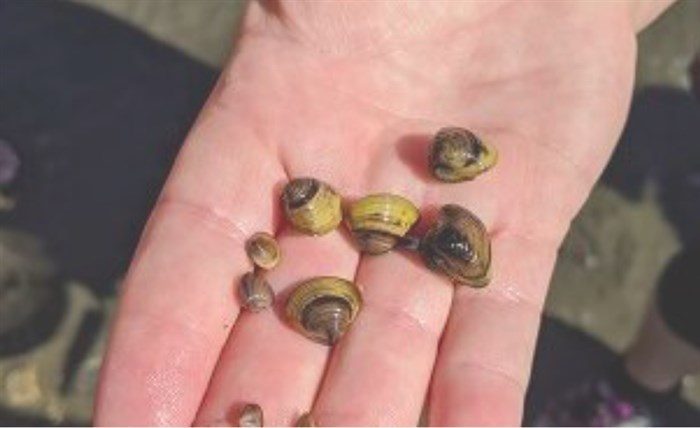
An invasive species of clam native to eastern Asia, Corbicula fluminea, have been found in Shuswap Lake.
Image Credit: SUBMITTED / Columbia Shuswap Invasive Species Society
December 04, 2020 - 7:30 AM
Colonies of an invasive freshwater clam have been found in Shuswap Lake. Left unchecked, the clams could clog water intake pipes and cut into food supplies for fish.
“At this stage, the best option is to have boat owners do a very thorough cleaning, draining and drying of your boat, or any other gear that’s been in the water,” Sue Davies, aquatic invasive species coordinator for the Columbia Shuswap Invasive Species Society, told iNFOnews.ca.
That means cleaning all the mud and debris off the boat, removing the drain plug and emptying all the water from the boat, including the engine coolant system, then making sure it’s dry before going into another lake.
The Corbicula fluminea clam larvae are microscopic in size and can live in just a tiny bit of water.
Shells were spotted on a beach in the Salmon Arm of Shuswap Lake last year, Davies said. Her society was notified in November, but it wasn’t until mid-September of this year the water levels were low enough to check for live clams.
Small live populations of the clams, which are native to eastern Asia, were found at Sunnybrae and Canoe, and investigators recorded about 20 clams per square metre of the lake bed.
But they were only able to check one-half to one metre into the lake. The clam is a bottom dwelling creature with a range down to 10 metres so scuba divers will be needed to do a thorough search.
Each clam can produce up to 70,000 eggs per year so densities can grow to 10,000 per square metre.
Unlike the zebra and quagga mussels, the clams don’t cling to the sides of boats and docks so are generally not considered as harmful or as easy to transport.
Both mussels and clam larvae live in water and can be invisible to the naked eye but the mussels can also be spotted clinging to boats.
While there are inspection stations for boats coming into the province in an effort to keep the mussels out of B.C., it’s much more difficult to check boats going between lakes within B.C., Davies said.
Ideally, boat washing stations would be established at Shuswap Lake, but that’s up to senior government. The society also wants the province to develop a management plan to deal with the infestation.
How much damage the clams can do to the water intake pipes or fish food habitat is unknown since their impact ranges greatly in other lakes where they’ve been found.
Right now, they seem to be moving slowly down the Salmon Arm towards Sicamous but have not been spotted in obvious habitat further east than Canoe, as of yet.
If they spread, they could continue down into the South Thompson River.
They have also been found in the southern part of Osoyoos Lake, on the U.S. side, but not on the Canadian side yet.
They’ve also been found in lakes in the Fraser Valley, on Vancouver Island, in 38 U.S. states and three Great Lakes.
The clams are sometimes kept in aquariums, used as bait or consumed by people.
The Shuswap Lake clams may have been dumped out of an aquarium but their origin in not known. Nor does Davies know how long they’ve been there. Anecdotally, some people on the beach said they’ve seen them for years.
In mid-January a stakeholder’s meeting will be held to better inform the public and governments about the existence of the clams and the potential damage they can do.
“For their own enjoyment of the lake, it’s very important that they know best how not to accidentally transfer these invasive species, because the impact of invasive species can be huge,” Davies said. “It’s not only the recreational qualities of the lake, it’s drinking water, it’s the economy, the cost of managing these species the loss of potential fishing stocks and the loss of our beautiful sandy beaches to a system of beaches that are full of sharp, nasty little shells.”
Details of the open house will be posted on the Columbia Shuswap Invasive Species Society’s web page here.
For more information on the Corbicula fluminea clam, go here.
To contact a reporter for this story, email Rob Munro or call 250-808-0143 or email the editor. You can also submit photos, videos or news tips to the newsroom and be entered to win a monthly prize draw.
We welcome your comments and opinions on our stories but play nice. We won't censor or delete comments unless they contain off-topic statements or links, unnecessary vulgarity, false facts, spam or obviously fake profiles. If you have any concerns about what you see in comments, email the editor in the link above.
News from © iNFOnews, 2020